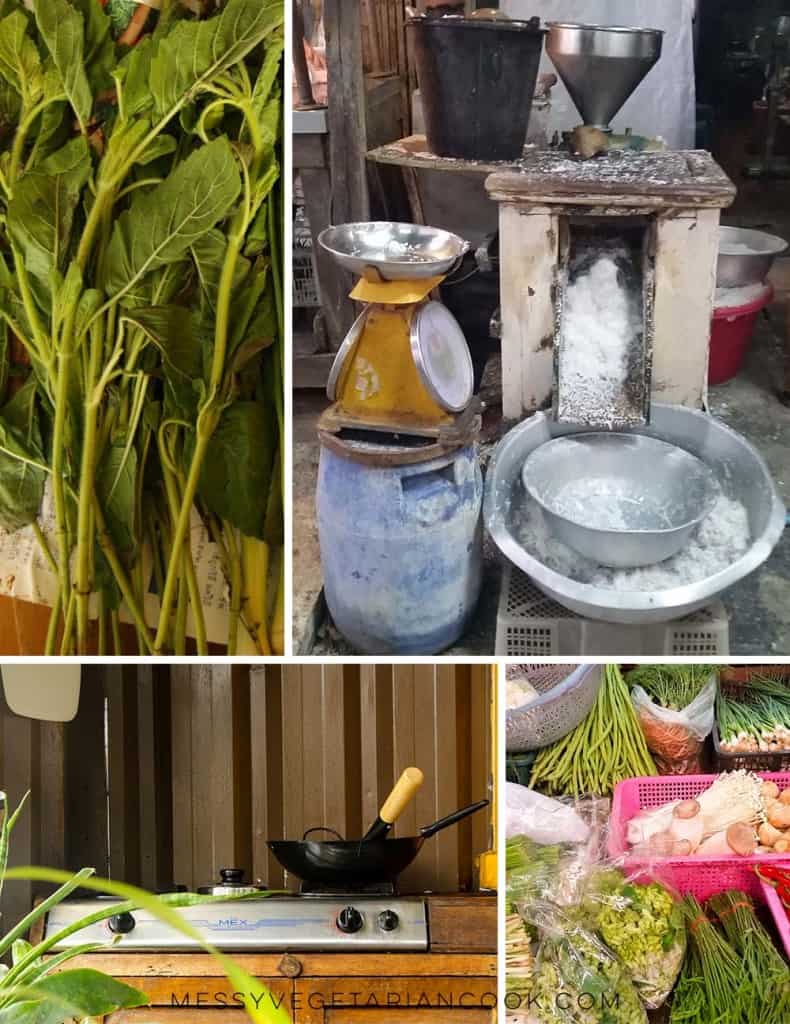Pad gaprao / kaprow is often called pad krapow for a linguistic reason I have yet to understand (this is not the correct transliteration, but Thai people are also prone to favour this pronunciation), pad kaprow (gaprao) is one of the easiest Thai recipes you can get under your belt. My use of fermented tofu is unusual, but it works.
After years of visiting Thailand, writing about its food and the annual vegetarian festival, I decided it was time to try to learn some of the language. So hello from Bangkok, where I am sitting in a small Asoke flat scattered with notes of how to say and write statements in Thai like "bullshit" and "the ghost licks underwear."
I'm learning useful words and concepts too, but I am so relieved to have a teacher who thinks fart jokes are funny (because they are) and who is down with impromptu two minute dance parties. The lessons are difficult but fun, and hopefully within the timespan of my life I will be able to read some of the Thai cookbooks I have collected over the years.

Pad gaprao (or kaprao, depending on transliteration) is a classic Thai dish that you might be familiar with given its presence on the menus of Thai restaurants worldwide. Gaprao is a simple stir fry that comes together quickly, but the secret to a good gaprao is in the name. Literally.
In Thai 'gaprao' means holy basil and 'pad' means fried, so the name of the dish translates to stir fried holy basil. This type of basil has a mild peppery flavour with a subtle spiciness and no other type of thai basil acts as a suitable substitution.
Five minutes' walk from my flat is a local market selling cheap fruits and vegetables, grated coconut and pressed coconut milk, stacks of tofu, and several varieties of fresh rice noodles. The market is not only a good place for me to practise speaking the language, but also a chance for me to amass collections of herbs that cost a fortune back home but pennies here. Gaprao is almost always on my shopping list, and on days when I have limited time between Thai lessons I more often than not opt for a quick pad gaprao for lunch.
I usually don't enjoy a gaprao eaten at a Thai restaurant outside of Thailand for one of two reasons: either they use horapha basil (the sweet anise scented basil most commonly called Thai basil) or they use too little holy basil. All the more reason to make it at home - you can control how much or how little holy basil is added based on your own taste.
For this recipe you can use any mildly flavoured (and not too salty) seitan, crumbled tofu, TVP, or vegetables. Make sure to serve kaprao with plenty of jasmine rice, a habit that took me years to break into and that I am forever trying to impress upon friends and family - the centrepiece of the meal is rice, and everything else is there to flavour it.
Incidentally, notice the fork and spoon in the photo above? A few people have asked me recently what's up with utensils in Thailand and the answer is pretty straightforward: if it's a Chinese noodle dish then chopsticks are used. Otherwise, all is consumed with a fork and spoon (including Thai noodle dishes).
📖 Recipe
Vegan pad gaprao (kaprao, kaprow, krapow, etc...)
Ingredients
- 1 cube fermented white tofu
- 1 teaspoon Thai dark soy sauce
- 1 teaspoon Thai thin/light/white soy sauce e.g. Healthy Boy brand
- 1 teaspoon seasoning sauce e.g. Golden Mountain brand
- ½ teaspoon white sugar
- 1 tablespoon vegetable oil
- 1-5 bird's eye chilies thinly sliced
- 1 tablespoon roughly chopped garlic
- 1 heaped cup minced/finely diced seitan OR crumbled firm tofu
- 1 cup holy basil leaves (bai kaprow, kaprao, gaprao) see notes1
- Chili vinegar see notes2
- white pepper
Instructions
- Combine the fermented tofu, soy sauces, seasoning sauce, and sugar in a small cup or bowl, using a fox to mash the tofu.
- Heat a wok to high and add the oil. When it becomes to smoke, add the garlic and sliced chilies, stir frying until fragrant and the garlic begins to lightly brown (15-30 seconds). Add the seitan or crumbled tofu and stir fry rapidly for a minute or two until hot and starting to brown.
- Tip the sauce in, and quickly stir fry to combine. After a minute, turn the heat off and tip the holy basil leaves into your wok. Continue to toss the contents until the leaves wilt slightly. Serve immediately with 17 tonnes of white rice and chili vinegar, and ideally with a vegan fried egg (see notes3). Season with white pepper.
Notes
- There are a few types of basil employed in Thai cooking. For an explanation of these leaves, you can look at my guide to types of basil used in Thai cooking.
- Chilli vinegar, or nam som prik dong, is easy to make yourself.
- Pad kaprow is often served with a fried egg, or kai dao. You can try my vegan fried egg recipe if you fancy it.